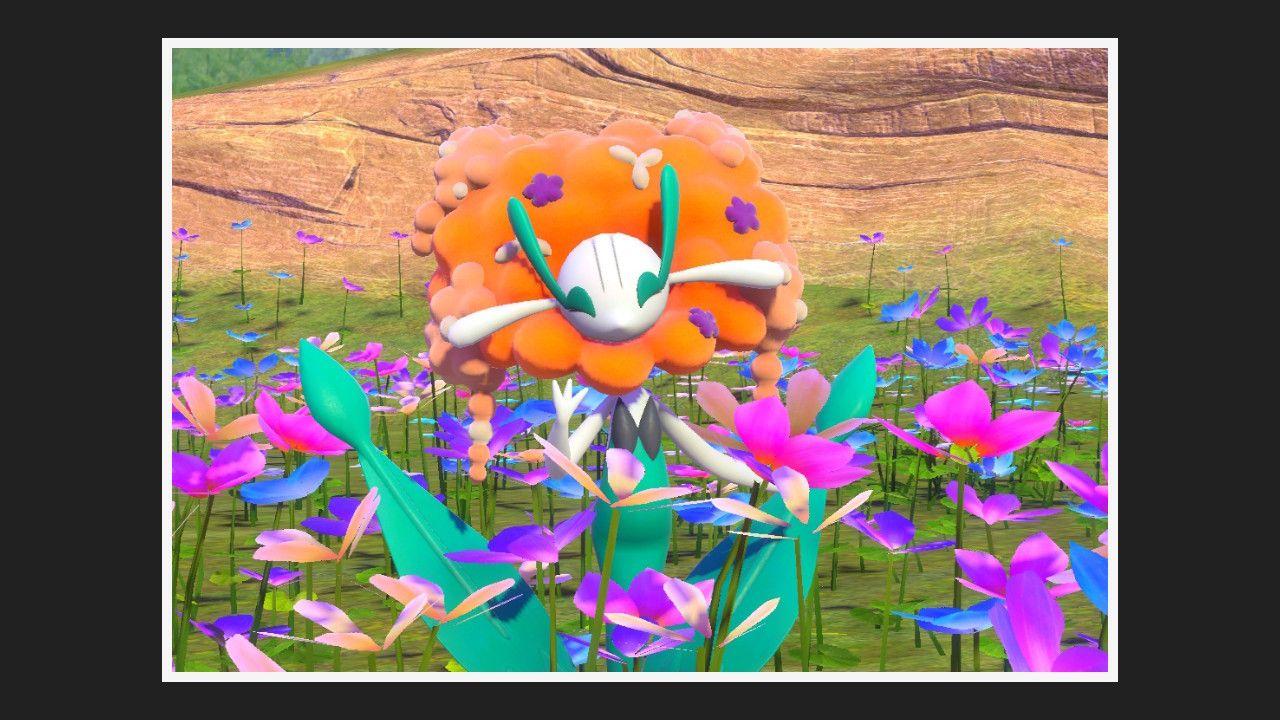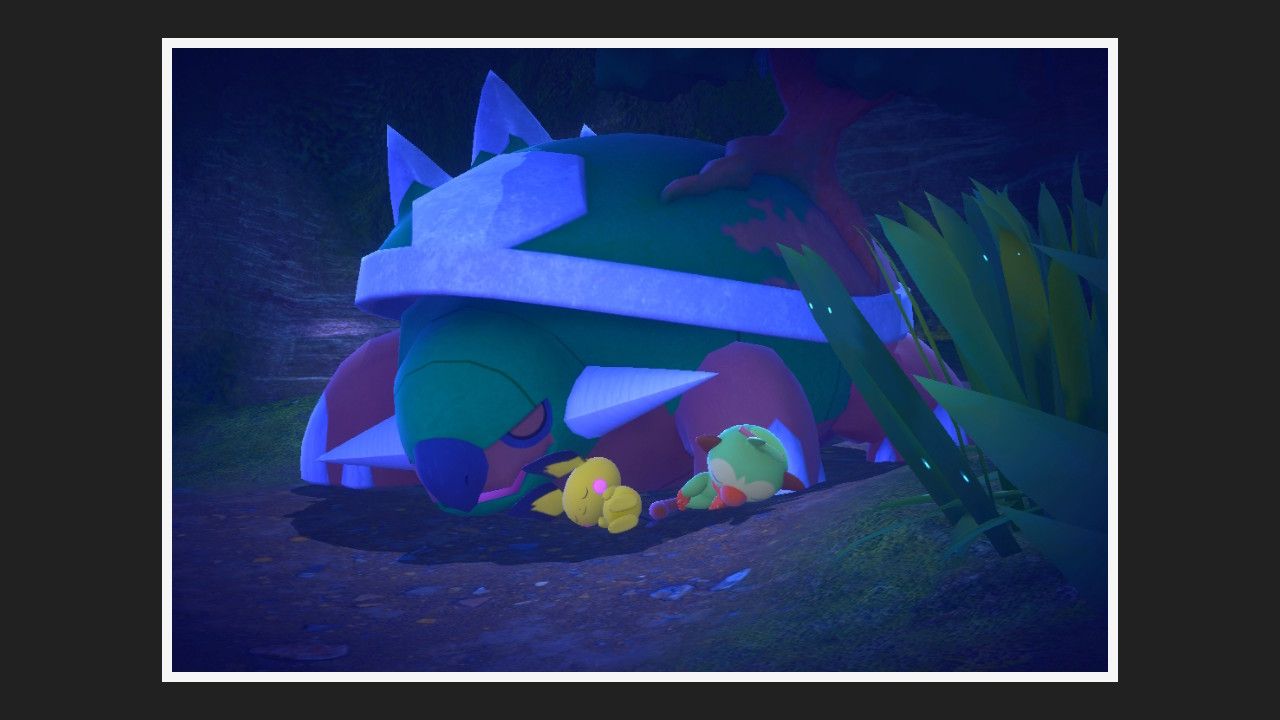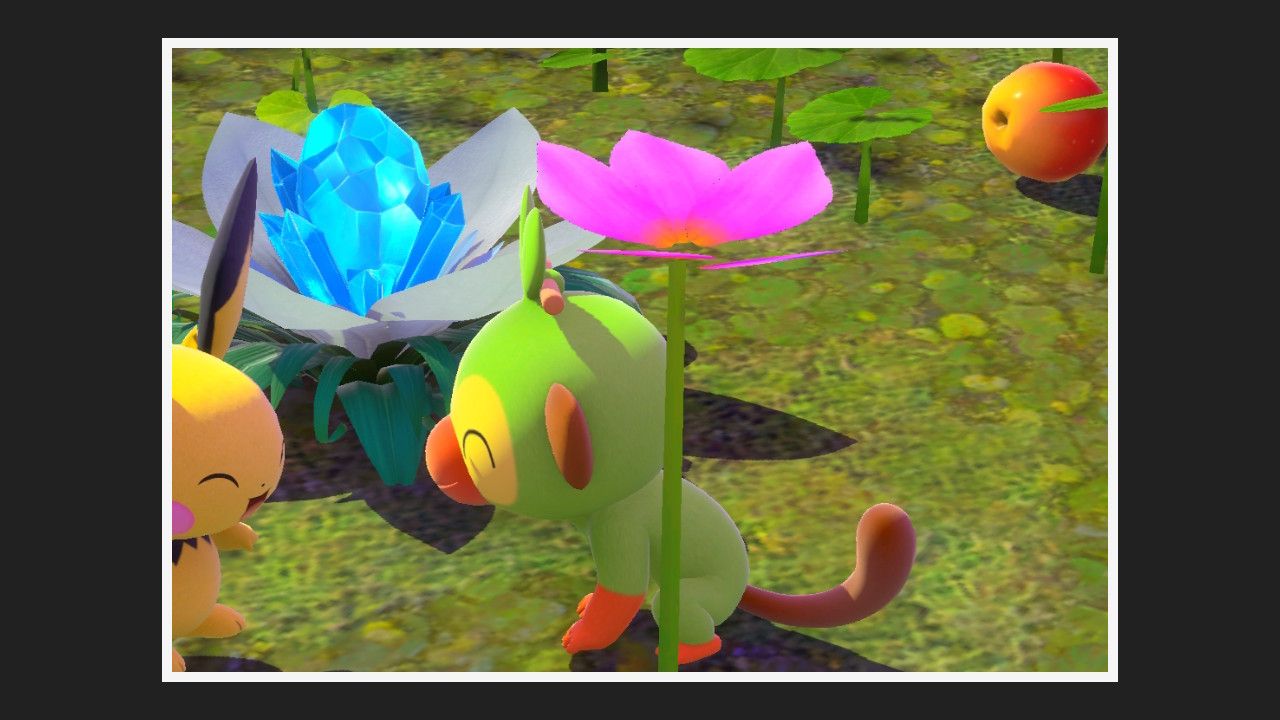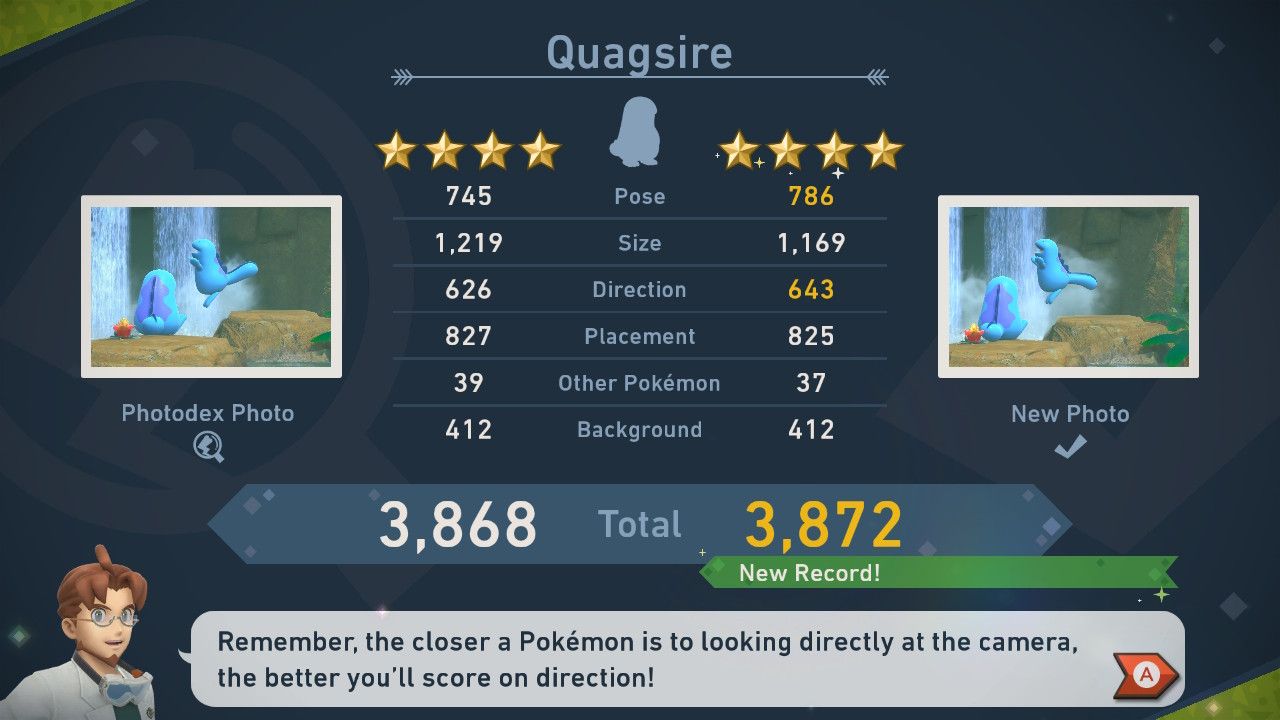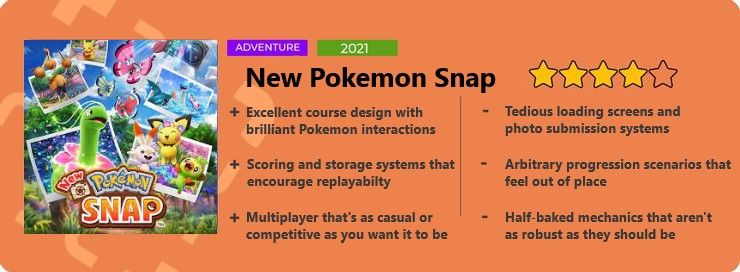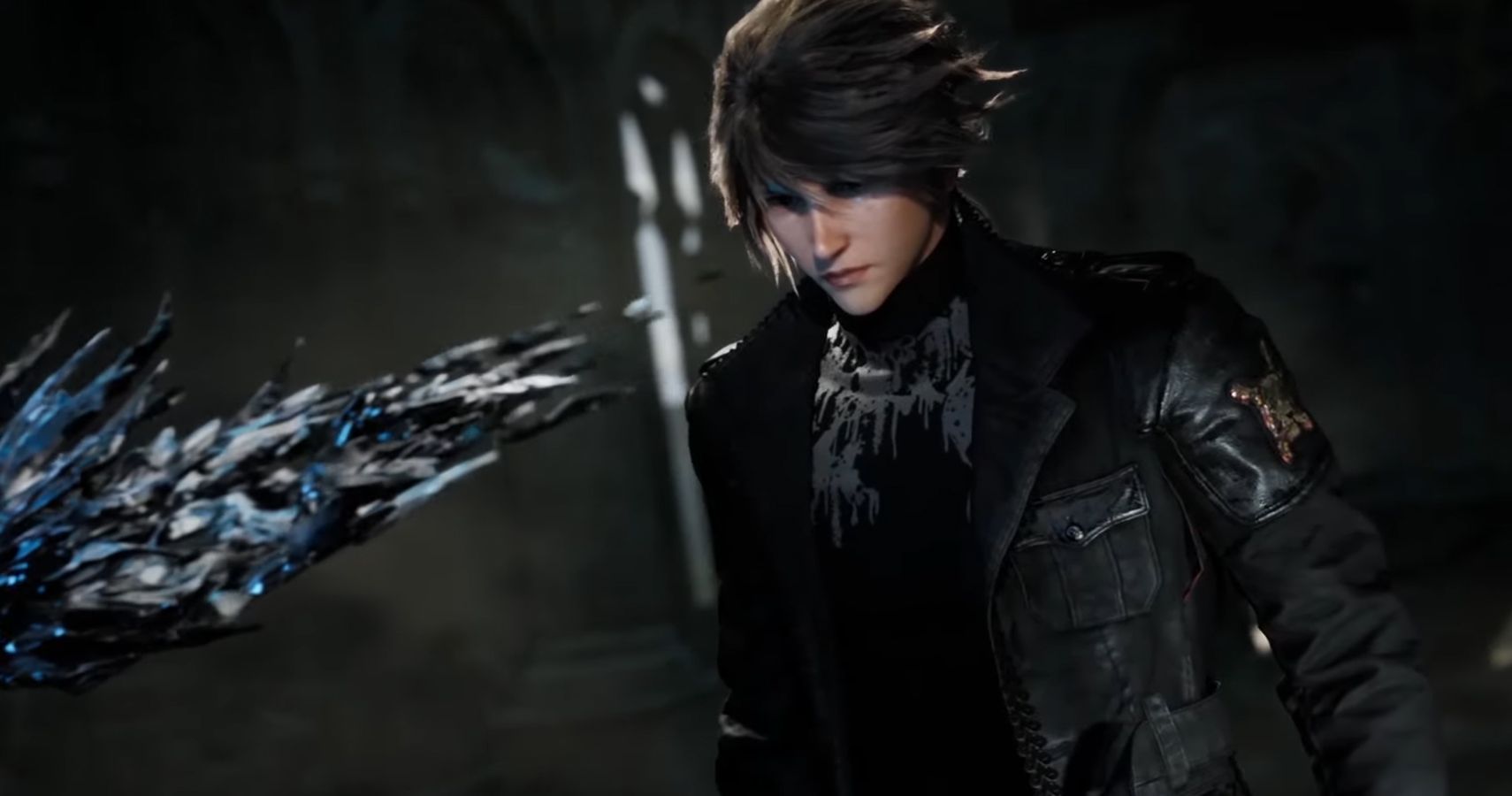Grookey and Pichu dash between the legs of an enormous Bouffalant herd before coming to a halt in front of your NEO-ONE, a hi-tech railcar that combines Jurassic World’s spherical vehicle design with Jurassic Park’s, er… rails. As Grookey bangs his stick on the ground like a toddler with an object they have been explicitly told not to break, the world of Florio Park behind it begins to open up: there’s Dodrio and Vivillon, Bidoof and Emolga, Wurmple and Taillow and Florges and – later on in the game – a whole heap of other, more traditional fan favourites. For someone as invested in this world as I am, New Pokemon Snap is a must-play experience, a spectacle that drastically supersedes its 1999 predecessor.
Minus the catching and battling and other morally murky elements of mainline Pokemon – as per Team Plasma, at least – there’s actually a whole lot going on in New Pokemon Snap. The Lental region, an archipelago comprising oceanic havens, thick jungles, vast deserts, and everything in between, has already established itself as one of the series’ more alluring locations. Pikipek brings stray fluffruit up to Toucannon’s nest high in the treetops as Quagsire dives into the mouth of a waterfall to cool off beneath the beating sun overhead. Onix snakes its way through sweltering sands, diving underground and erupting skyward like a particularly violent bottlenose dolphin, while Sharpedo skulks through the shallow water encasing coral reefs exactly like how you’d expect a half-shark, half-torpedo to – quickly, raucously, and, if I’m honest, almost entirely nonsensically.
Your job in New Pokemon Snap is to photograph these phenomena. Pokemon are real posers once you crank out your camera, either schmoozing up to you in a way that says “look how amazing I am” or, in some cases, lambasting you for so much as assuming you can take their picture. But it’s a lambastment that says “how dare you! Wait, what do you mean you didn’t take a candid just now?”
Your photos are scored at the end of each course by Professor Mirror. There are two separate scoring systems, which, although partly connected, function on completely different levels. The star system, which assigns each photo a rating between one and four, mostly pertains to how unique the captured situation is. Pyukumuku lying on a rock? One star, maybe two. Pyukumuku being spat out of a Pelipper’s bill? Now that’s a four-star shot. The second system is the primary scoring structure, and revolves around conventional photography measures like pose, subject size, direction, placement, and so on. You’re able to hold four photos of every Pokemon in your Photodex at any given time – one for each star – with each individual score being added together to provide your total Photodex score for Venusaur, Hoothoot, or Magikarp.
But stars and scores are only half the fun, because the real magic comes from just drinking in the scenery around you. I often find myself going on preliminary scouting trips just to take in as much as possible – rather than line up a perfect Squirtle, I’ll look at who the Squirtle interacts with and what’s going on opposite it. I’ll look back, or forward, or up into the clouds above to pick out ‘mons I’d otherwise miss just to be sure I’ll catch them on their A-game in the next roll through each biome. You learn where Torchic is, who it’s with, when it moves – it’s strategic and meditative at the same time, a kind of noisy harmony that can only truly exist in a Pokemon region with little to no people – Rime City could never.
All of the above comes together via the request system. You’ll often get certain challenges from Professor Mirror and others – photograph a Scorbunny laughing or a Tyranitar pulverizing a rock into smithereens – that generally tend to result in capturing one of each respective Pokemon’s four-star poses. This also ticks another request off the list, though, some of which will offer you new research titles or emblems you can use to spruce up your multiplayer profile.
Multiplayer is obviously quite limited at the moment given that only a select few copies are out in the wild, but I can see it perpetuating this game for a long time to come. While it’s nice to admire other people’s shots, it’s also competitive – I saw a Blastoise shot yesterday that I was well jealous of and all I wanted to do afterwards was take an even better one, which I did not succeed in doing because I haven’t cracked the Blastoise code yet. Blastoise is my favourite Pokemon of all time, but until I figure out what makes it tick, I’m essentially wasting shots on a tortoise who has its cannons tucked in until you clock it with three fluffruits – sure, the pelting mechanic from the original is gone, but you can – and must – chuck apples at ‘mons every so often.
I’m not going to go into much detail on the story, but I can at least say it was satisfying, both in terms of pacing and the execution of its conclusion. The only issue with pacing is a lack of clarity on occasion, where New Pokemon Snap requires you to recognize an immensely arbitrary action with little to no guidance on where, when, or why you need to do it. I hit a wall in the middle where I became disheartened fairly quickly, a devastating low point in a game that otherwise felt comfortable soaring through the stars. This happened a second time towards the end, albeit for a much shorter time.
There are other issues with New Pokemon Snap, too. There are loading screens everywhere, which is starkly noticeable in the current-gen console climate. The rating screen after a course run can be extremely tedious due to the fact that Professor Mirror has a single line he regurgitates approximately one to 25 times per run, which is sometimes interrupted by a “new Pokemon!” animation as tedious as the mainline series’ outdated-by-two-decades battle code. There are certain set pieces in the game that are similarly imbued with tedium, transpiring over unnecessarily long windows that actively detract from how special they could feel with a degree of brevity intact.
That’s not to mention the suite of mechanics you’re given to use, which are far less robust than the game seems to believe. Feats more tied to RNGesus than skill are often demanded of you, with impossibly arcane projectile arcs swallowing 30 seconds of a two-minute section only to be rewarded with pictures of a nice but ultimately ordinary tree. The camera works great – although an adjustable lens would be nice – but the short number of other active inputs you have feel hamfisted in for ostensible but ankle-deep diversity in setting up complex shots.
Despite all of this, New Pokemon Snap is an excellent game that anyone fascinated with Pokemon will adore. After finishing the main story in 20 hours, I’ve plugged at least another five exploring courses I’ve already been through ten times only to find new ‘mons and scenarios everywhere I look. As it stands, I’m far more convinced of the Photodex’s validity than the Pokedex, although I wish Snap borrowed from the latter when it comes to not taking ten years to register that your new Swanna shot is only worth 3,582 points compared to your previous score of 3,579. You learn way more about the ‘mons, but it occasionally feels like you’re in the Trainer’s School every mainline game tries and fails to make us spend more than five seconds in.
New Pokemon Snap has issues when it comes to tedium between courses, arbitrary solutions, and boring, barely functional extra mechanics, but the courses and Pokemon are legitimately incredible. The Photodex is a marvel, multiplayer creates healthy competition for replayability , and just being able to inhabit Lental is a spectacle in and of itself. I’m not sure I’d recommend it to someone who can’t tell Bagon from Beldum, but if you’re a born and bred Pokemon fan, New Pokemon Snap could be your sleeper hit of the year.
Score: 4/5. A code for New Pokemon Snap was provided by Nintendo.
Next: Apex Legends Interview: Season 9, Valkyrie, Arenas, Olympus Infestation, And More
- Game Reviews
- Pokemon
- Nintendo
- Nintendo Switch
- Bandai Namco
- Pokemon Snap
- New Pokemon Snap
Cian Maher is the Lead Features Editor at TheGamer. He’s also had work published in The Guardian, The Washington Post, The Verge, Vice, Wired, and more. You can find him on Twitter @cianmaher0.
Source: Read Full Article
